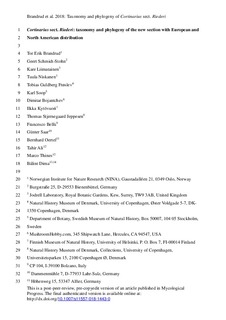Cortinarius sect. Riederi: taxonomy and phylogeny of the new section with European and North American distribution
Brandrud, Tor Erik; Schmidt-Stohn, Geert; Liimatainen, Kare; Niskanen, Tuula; Frøslev, Tobias Guldberg; Soop, Karl; Bojantchev, Dimitar; Kytövuori, Ilkka; Jeppesen, Thomas Stjernegaard; Bellù, Francesco; Saar, Günter; Oertel, Bernhard; Ali, Tahir; Thines, Marco; Dima, Bálint
Journal article, Peer reviewed
Accepted version

Åpne
Permanent lenke
http://hdl.handle.net/11250/2580728Utgivelsesdato
2018Metadata
Vis full innførselSamlinger
- Publikasjoner fra CRIStin - NINA [2364]
- Scientific publications [1392]
Originalversjon
10.1007/s11557-018-1443-0Sammendrag
Cortinarius is one of the most species-rich genera of mushroom-forming fungi. Based on phylogenetic and morphological evidence, Cortinarius, sect. Riederi, is introduced at sectional level (= subsect. Riederi sensu Brandrud & Melot). The taxonomy, phylogeny, ecology and distribution of not only mainly European but also including some NorthAmerican taxa of this section are treated, which includes nine species and two varieties. Of these, three taxa are described as new (C. burlinghamiae, C. pallidoriederi and C. argenteolilacinus var. dovrensis). The sect. Riederi species possess morphological features similar to Phlegmacium group(s) and forms a phylogenetically isolated lineage, with no supported affinity to other phlegmacioid groups. Three taxa are known from both Europe and North America, two species are known only from North America and five only from Europe. Altogether, eight of the ten taxa are associated with conifers or northern (boreal-subalpine) deciduous trees (Betula spp.). Only two species occur in more temperate forests (Fagus forests), and no species have so far been found in thermophilous Quercus forests Agaricales . Basidiomycota . Ecology . Morphology . nrDNA ITS . Phlegmacioid